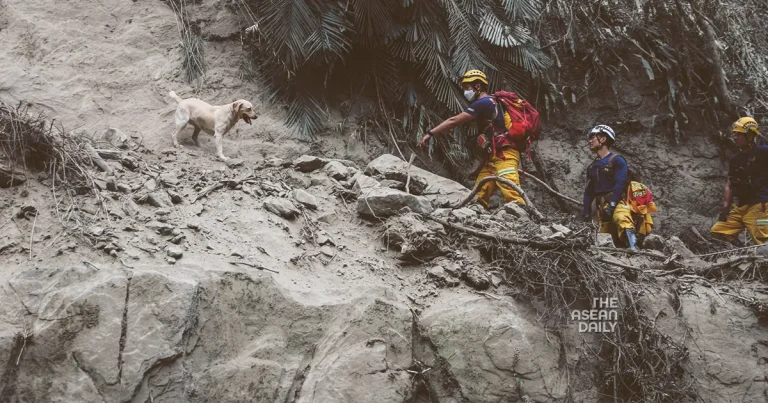7-4-2024 (TAIPEI) Rescue operations are ongoing in rural Hualien county, Taiwan, as approximately 340 people remain stranded in the mountains three days after the country experienced its strongest earthquake in 25 years. The earthquake caused buildings to collapse and triggered landslides, leading to the isolation of these individuals. While authorities have confirmed that those stranded have access to food and water and are considered safe, their predicament persists due to blocked roads and tunnels caused by massive boulders.
Rescue teams are racing against time, facing constant aftershocks and challenging weather conditions, in their search for six missing people, including a couple from Singapore. The two individuals were last seen on April 3 when they disembarked from a tour bus in Taroko Gorge, located in Hualien county, on the morning of the earthquake.
Taiwan’s Immigration Agency released a statement on April 6 affirming that they are in contact with the families of the missing Singaporean couple.
The death toll from the 7.4-magnitude earthquake, which originated in the waters off the eastern coastal county and struck at approximately 8 a.m., has risen to 13. Three bodies were discovered on a walking trail. Over 1,000 individuals have been reported injured.
On April 6, helicopters from the National Airborne Service Corps were deployed to inaccessible areas of the national park to rescue dozens of stranded tourists. Among those airlifted to safety were guests who had been staying at the Silks Place Taroko hotel, a luxury establishment situated deep within Taroko Gorge.
Pastor Mr. Zhou, who was rescued from the area, expressed his relief but also shared his unease caused by subsequent aftershocks. “The subsequent aftershocks were very large and serious,” he told reporters upon his arrival at the rescue command centre in the gorge. “I felt very nervous when I was sleeping.”
The rescue command centre in Taroko Gorge was bustling with activity when The Straits Times visited on April 6. Rescue workers from various counties had set up workstations and were conducting initial health checks on evacuees. A group of 13 tourists of different nationalities, visibly relieved, arrived by bus but declined interviews.
Since the initial quake, Taiwan has experienced over 600 aftershocks, some of which were strong enough to prompt phone alerts advising the public to remain calm and seek shelter.
These aftershocks, combined with intermittent fog and inclement weather, have hampered rescue efforts, according to Taiwan’s fire department. On April 6, the department was forced to suspend its plans to use heavy machinery to remove massive boulders in areas prone to landslides.
Nevertheless, rescuers successfully airdropped boxes of food and supplies to a group of students and teachers stranded at an elementary school that was inaccessible by road.
“Rescuers are not giving up,” said Taiwanese Vice-President-elect Hsiao Bi-khim, praising them as the “true heroes of a resilient Taiwan.”
The relatively low number of casualties resulting from such a powerful earthquake is attributed to the lessons learned from the devastating 7.6-magnitude quake in 1999, which claimed the lives of 2,400 people.
These lessons include stricter building codes mandated by the government and widespread public education on disaster preparedness in this earthquake-prone region.
Hualien resident Hsiao Yo-juan remarked, “The news keeps reporting how other countries are impressed with our earthquake preparedness, but it’s just what we’ve been taught to do since we were young.” Yo-juan added that taking cover during a quake is a natural response for everyone.
Most of the victims of the April 3 earthquake were outdoors when they were struck by falling rocks or caught in landslides while hiking or driving.
The death toll could have been significantly higher if the earthquake had occurred just one day later. Many travellers would have been on the roads as they embarked on a four-day long weekend to celebrate Children’s Day and the Qing Ming Festival, a time when families gather to honor their ancestors.
In central Hualien City, demolition work continues on the Uranus building, a 10-storey structure housing shops and flats, which has become an iconic symbol of the quake due to its severe tilting.
Ms. Lin, a Hualien resident who watched cranes demolish the brick walls of her former home, tearfully expressed her emotions. “I knew there was no way to salvage the building, but it’s still heartbreaking to watch,” she told reporters. “But I’m not complaining. I’m very lucky to be alive.”
Similarly fortunate are a Singaporean engineer and his girlfriend, who managed to escape barefoot from their shaking third-floor accommodation in Hualien City when the earthquake struck. With the assistance of locals, the couple safely left the city and secured a flight back home to Singapore from Kaohsiung.




